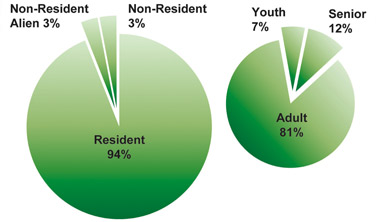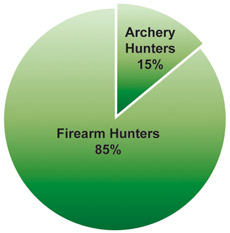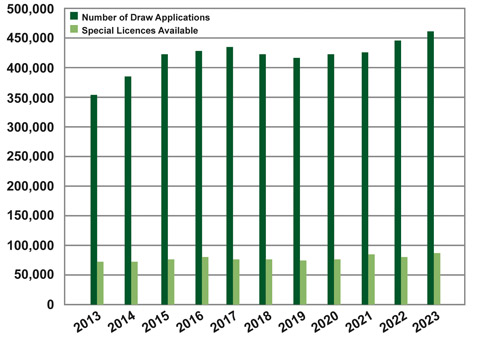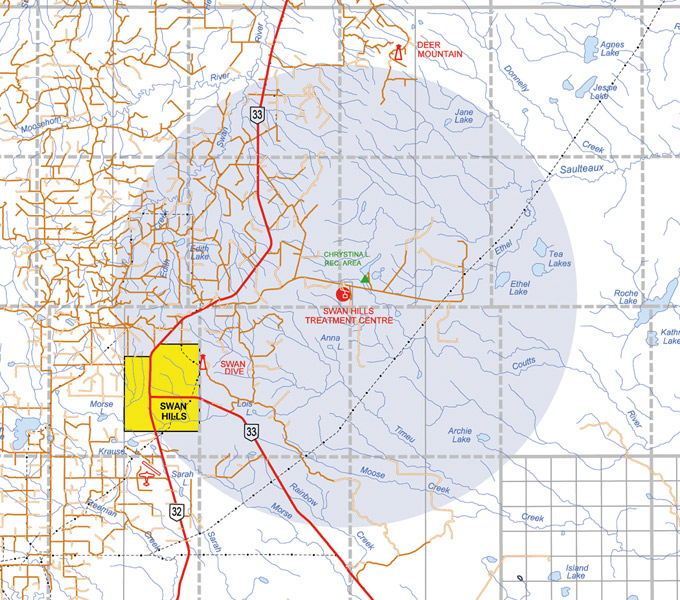

Where did your 2023/24 Hunting Licence Dollars go?
Hunters in Alberta in 2023
● 164,985 hunters hunted in Alberta.
● 5,896 Non-Residents
● 8,004 Non-Resident Aliens

Resident Hunters in Alberta in 2023
● Over 151,085 resident hunters in Alberta.
● 15% purchased Bowhunting Permits.
● 52% purchased Game Bird Licences

Youth and Senior Hunters in Alberta in 2023
● Youth/Senior Wildlife certificates, which include a Game bird licence, are available for $12.00 in 2024. Over 30,000 were sold, 11,200 Youth and 19,600 Senior.
● Youth/Senior White-tailed Deer and Youth Mule Deer are available for $12.00.
Over 20,100 White-tailed Deer were sold, 7,500 Youth and 12,500 Senior.
Over 800 Youth Mule Deer licences were sold. .
● Did you know that you can legally share almost any big game Special Licence opportunity with a Youth or Senior hunter using the Partner Licence for only $12.00. Over 250 youth and 500 Senior hunters took advantage of this opportunity allowing them to hunt elk, moose, bighorn sheep, pronghorn antelope and wild turkey.
Hunter Hosts in Alberta in 2023
● Over 2,950 Albertans hosted over 7,600 friends and family to hunt with them in Alberta.
● Over 4,300 hosted hunters were Canadian.

Madatory Harvest and Effort Reporting
Regulation requires mandatory reporting of harvest and effort on all special hunting licences purchased. Visit AlbertaRelm.com for more information on how convenient it is to report harvest and effort including the introduction of a new APP.
Harvest and effort information is essential to providing resource managers indicators of overall wildlife populations. Without this information, the department must rely on more intensive and costly wildlife surveys.
Hunters failing to submit harvest and effort survey results for 2024 special licences purchased will be subject to a $15 survey surcharge payable on their next wildlife certificate purchase.
Congratulations to the lucky hunter that has been awarded a free 2024 special licence just for completing their 2023 hunter harvest and effort survey!
Hunters will continue to be entered for a chance to win a special licence hunting opportunity for either a Moose, Mule Deer, Antelope or Elk for each harvest and effort survey completed.
Please visit mywildalberta.ca to see 2023 hunter harvest and effort survey results..
Fish and Wildlife Officers help conserve and protect the province’s wildlife by ensuring everyone understands and complies with the laws in Alberta. Hunters are reminded to ensure that they are familiar with the hunting regulations and season dates for the areas and species that they plan to hunt.
In 2023, the top 5 offenses were:
1. Unlawful possession of wildlife.
2. Loaded firearm on vehicle/boat/aircraft.
3. Hunt wildlife without a licence.
4. Hunt wildlife during a cloaed season.
5. Fail to retain evidence on sex/species on animal carcass.
Source: Fish and Wildlife Enforcement Services, Public Safety and Emergency Services.
Some species of wildlife are banded, collared or marked by other means in an ongoing effort to gain additional population biology information.
A person who kills a wildlife animal or finds a dead wildlife animal that has been fitted with a device for the purpose of tracking the animal’s movements shall submit a completed report provided by Fish and Wildlife.
Some of these marked wildlife, as well as certain nuisance animals (e.g., some black bears), may have received drugs for research purposes or to facilitate their capture and handling. Any such animal will be marked with a tag advising that the meat of the animal should not be consumed before contacting Fish and Wildlife of Alberta Forestry and Parks.
Report Waterfowl Leg Bands by Telephone or Internet
All waterfowl leg bands recovered in North America can now be reported by telephoning the toll-free number 1-800-327-BAND (1-800-327-2263). Band recovery can also be reported by internet at the website reportband.gov.
Chronic wasting disease (CWD) is a chronic degenerative and ultimately fatal prion disease of cervids (primarily mule deer in Alberta). It is not known to infect humans but health authorities advise against eating any animal known to have any prion disease. CWD occurs throughout much of eastern and central Alberta. Previous information, including maps of known cases is available at alberta.ca/chronic-wasting-disease-updates.
Hunters and outfitters are key in assisting big game management by helping to reduce deer numbers and by providing heads from harvested deer in designated areas for the CWD surveillance program. Alberta began looking for CWD in wild deer in the hunting seasons in 1998. Since then, we have tested over 114,000 heads and found CWD in 5,179 mule deer, 930 white-tailed deer, 39 elk, and 15 moose.
FOR 2024: Mandatory DEER: WMUs 148, 150, 151, 200, 234, 236, 728, and 730 .
Mandatory mule deer and Voluntary white-tailed deer: WMUs 503, 504, 505, 506, 509, 510, 514.
Mandatory MULE DEER ONLY: WMUs 108, 110, 212, 216, 221, 224, 246, 247, 248, 250, 300, 302, 303, 306, 308, 310, 312, 314, 316, 320, 334, 402, 404, 508.
Antlers and skull plate can be removed from bucks before the head is submitted. For European mounts, watch some YouTube videos and then collect the obex AND both retropharyngeal lymph nodes. The Alberta surveillance program uses all three tissues.
All heads for testing, including samples (as above), must have a green CWD label which gives each head a unique identification number. Be sure to include either GPS or land location as well as WMU and your WiN number for each head. When available, test results for each head are sent to the email address in the hunter’s AlbertaRELM account.
CARCASS DISPOSAL
All hunters should properly dispose of their harvested carcasses, particularly animals taken in the CWD Risk Area. Where possible, debone meat making sure you keep the required evidence of sex and species. Hunters may prefer to avoid the spinal cord when deboning. Leave remainder of carcass at the kill site. If the carcass is transported elsewhere, remove all useable meat, then burn, bury, or dispose of the remains in a landfill.
For more information about CWD, contact your local Fish and Wildlife office or visit alberta.ca/chronic-wasting-disease.
Alberta Health recommends that deer from the CWD mandatory areas be tested for CWD. For more information about potential human health risks associated with CWD contact health authorities.
IMPORANT THINGS TO KNOW:
Report A Poacher can be reached all day, every day.
1-800-642-3800
● All calls are kept strictly confidential and you can remain anonymous.
● If you see something that may be poaching, record as much information as possible:
- Date and time
- Location
- Vehicle description and licence number
- Description of who was involved in the crime
- Details of the violation and any other details you can think of, no matter how insignificant they might seem
● The information you provide could lead to a conviction (and possibly a reward for your help).
● Poaching covers a wide range of violations including:
- Fishing or hunting out of season
- Night hunting
- Hunting from the road
- Exceeding limits
- Hunting while intoxicated
- Illegal sales of wildlife or fish
● The Report A Poacher line can also be used for reporting major violations to land and habitat such as tree harvesting or destruction of stream beds.
● Please familiarize yourself with Alberta's Hunting and Fishing regulations to help protect Alberta.
The wild game public health advisory for the Swan Hills area – originally issued on December 13, 1996, by the Provincial Health Officer – has been revised as a result of more extensive wild game testing. While recent test results confirm that eating wild game from the Swan Hills area poses no immediate threat to human health, it is recommended that individuals limit the amount of wild game eaten.
For more information contact Alberta Health and Wellness at 780-427-7164 or visit My Wild Alberta at
mywildalberta.ca/hunting/safety-procedures/harvested-wildlife-human-health.aspx.
Swan Hills Treatment Centre
15 km radius around Swan Hills Treatment Centre

GENERAL MULE DEER LICENCE
This general licence is valid during the “archery only” season, which precedes the general season. It is valid during the general season in the following WMUs: 352, 353, 355, 440-446, 512-519, 528-534, 536, 539-542 and 841. This licence is not valid during a season in which a Special Licence is required. In the Alberta Guide to Hunting Regulations, special licences are required for all seasons where a small black box is located beside the season date.
SUPPLEMENTAL ANTLERLESS WHITE-TAILED DEER LICENCE
The Supplemental Antlerless White-tailed Deer Licence is issued with one tag. This tag is valid in the following WMUs: 200-208, 214-246, 248, 258-260, 300, 304-305, 310-314, 320-322, 332-337, 344, 348, 350-353, 355, 357-360, 440-446, and 500-544.
YOUTH MULE DEER LICENCE
This general licence is available for resident hunters who are 12-17 years of age and who are eligible to hunt. It is a general licence that is valid during the “archery only” season, which precedes the general season. It is valid during the general season in the following WMUs: 352, 353, 355, 440-446, 512-519, 528-534, 536, 539-542 and 841. This licence is not valid during a season in which a Special Licence is required. In the Alberta Guide to Hunting Regulations, special licences are required for all seasons where a small black box is located beside the season date.
YOUTH/SENIOR WHITE-TAILED DEER LICENCE
This licence is valid for resident hunters who are 12-17 and 65 years of age and over who are eligible to hunt. It is a general licence and is valid during a general season (archery or rifle). Because it is a general licence, it can not be used during the rifle season in WMUs 404, 406 and 408 (a special licence is required). In the Alberta Guide to Hunting Regulations, special licences are required for all seasons where a small black box is located beside the season date.
SUPPLEMENTAL BLACK BEAR LICENCE
This licence is only valid in WMUs 224, 250, 258, 260, 320-360, 429, 445, 500-544 and 841.
SPECIAL LICENCES
If you are drawn for a special licence, your draw priority returns to zero and that draw cannot be cancelled. You may not be able to purchase a particular general licence once you have been drawn for a special licence of that same species. Example: if you are drawn for Antlered Mule Deer, Antlered White-tailed Deer or Antlered, Antlerless, or Calf Moose you will not be able to purchase a general licence for that species. If you are drawn for Either Sex Elk, WMU 300 Elk, Antlered or Antlerless Elk, you will not be able to purchase a general elk licence. Resident hunters are able to purchase an elk licence in combination with the WMU 212 Antlerless Elk Archery and the WMU 212 Antlerless Elk Special Licence. See licence combinations.
The Alberta Guide to Hunting Regulations is published annually by Sports Scene Publications Inc. 10450 - 174 Street, Edmonton Alberta T5S 2G9. The publisher is responsible for the content of this publication, and is licensed by Alberta Forestry and Parks to publish the summary of the hunting regulations contained herein.
Copyright in Provincial Statutes and Regulations, whether in print or electronic format, belongs to the Province of Alberta. No person may reproduce copies of Alberta Statutes and Regulations for any purpose without the prior consent of the King’s Printer for Alberta.
The contents of this website are provided free-of-charge to all hunters in Alberta. With the exception of short quotations for review purposes, no portion of this document may be reproduced without written permission from Alberta Forestry and Parks or Sports Scene Publications Incorporated.